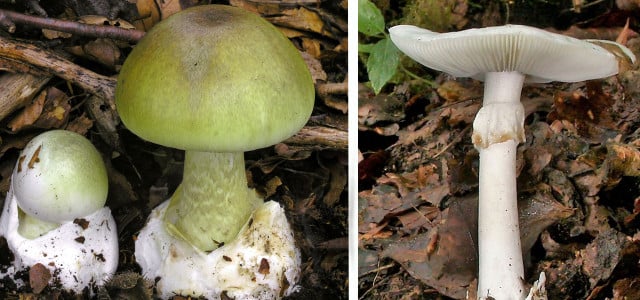
Mushroom season drives many people into nature. But death cap mushrooms should under no circumstances end up in the basket: there is a danger to life, as is the case with three children in Essen. The poisonous mushroom is easy to confuse. What you need to know about the toadstool.
Mushrooms, porcini mushrooms, chanterelles: the autumn months invite you to collect mushrooms. But caution is also advised this year: varieties such as the green death cap mushroom (Amanita phalloides) are poisonous and easily confused with edible mushrooms.
There is a danger to life after eating mushrooms: This is also the case for three children who are treated for acute liver failure after eating death cap mushrooms. Your life is still in danger. In Essen, doctors are fighting for the lives of the young people affected. According to the Essen University Hospital, they were admitted to the children’s clinic on Tuesday night with acute liver failure and urgently needed an emergency transplant. In response to a dpa request, a clinic spokeswoman said the condition remained serious and that there were no new developments. Several experts warned urgently about the highly poisonous death cap mushroom.
The mushroom has it all: According to the German Liver Foundation, the green death cap is responsible for around 90 percent of deaths due to mushroom poisoning. It is therefore considered one of the most poisonous mushrooms found in Europe. How to recognize it and what to do in an emergency:
How do you recognize the green death cap mushroom?
According to the German Society for Mycology (DGfM), the mushroom is greenish in color, although the color can fade towards the edge. The mushroom’s cap is initially hemispherical, but over time it becomes flat and can reach a diameter of up to 12 cm. The stem is up to 10 cm long and about 2 cm thick. Another striking feature is the smell: it is reminiscent of artificial honey or a sweet invert sugar cream.
Caution: The death cap is often confused with edible mushrooms such as button mushrooms or green scallops. A mix-up can have fatal consequences.
At the top of the photo you can see the green death cap mushroom on the right and left. On the right in the picture is the pigmentless variety of toadstool, which is even more similar to edible white mushrooms. (Photo copyright: German Society for Mycology)
There is also a risk of confusion with other mushrooms:
- Collecting porcini mushrooms: Beware of these lookalikes!
- Recognizing meadow mushrooms: Beware of confusion!
- Collecting parasol mushrooms: There is a risk of confusion here!
- Crested Tintlings: Danger of confusion with other Tintlings
What symptoms appear if you accidentally eat the mushroom?
According to the German Liver Foundation, if you have eaten death cap mushrooms, symptoms of poisoning will only appear after several hours. Treacherous: By then the poison, the amatoxins, has already spread throughout the body. These poisons are particularly dangerous for children and older people.
The most common symptoms of poisoning are similar to a gastrointestinal infection: you feel unwell, have stomach pain, nausea, vomiting and diarrhea. Within 24 hours, the toxins begin to damage the liver, which can lead to blood clotting problems and kidney dysfunction. In the worst case, vital functions of the liver fail and only a liver transplant can save a life.
Suspected mushroom poisoning: what to do in an emergency?
Rapid medical help is required at the first signs of poisoning: You should then immediately call an emergency doctor or contact a poison control center. The Federal Office of Consumer Protection and Food Safety provides a list of the relevant poison emergency hotlines on its website.
It is important not to try your own treatment or use home remedies. Fungal residues and, if necessary, vomit should be saved and handed over to the doctor. This makes diagnosis and treatment easier.
How do you best protect yourself?
To protect yourself from mushroom poisoning, you should find out more about the types of mushrooms in advance – and not rely solely on apps or books to identify them, warns the German Liver Foundation. Even if mushrooms are infested with maggots or snails, that doesn’t mean they are non-toxic.
If in doubt: It is better to consult experts. There are so-called mushroom experts who examine the finds and give the green light for consumption. You can search for it on the website of the German Society for Mycology. However, the safest way to enjoy mushrooms is to buy them commercially.
Read more on Techzle\.com:
- Warming up mushrooms – is it dangerous?
- Identify mushrooms: 3 apps in comparison
- Edible mushrooms: You should know these 8 local species
** marked with ** or orange underlined Links to sources of supply are partly partner links: If you buy here, you are actively supporting Techzle\.com, because we then receive a small part of the sales proceeds. More info.